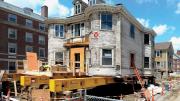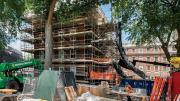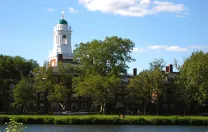Two days before Commencement, the College quietly published the summary of a “Strategic Assessment Report” on House renewal, the $1-billion-plus “first-phase” program to modernize the eight Neo-Georgian undergraduate residences along the Charles River (leaving newer parts of those Houses, and the Radcliffe Quad Houses, for some future date). The evaluation—conducted following the partial renovations of Quincy and Leverett Houses, and the complete overhaul of Dunster House—reveals successful elements of the physical and programmatic changes to the residences and highlights opportunities to refine and improve the rest of the project. It also underscores the very real financial challenges to be met if the project, as envisioned, is to be completed in a reasonable time, even given the successes of the current Faculty of Arts and Sciences (FAS) capital campaign.
Drawing on focus groups, interviews, survey research, and data on the use of renovated common spaces, the assessment revealed broad satisfaction with the renewed buildings’ role in increasing interaction among students; attracting students broadly to “neighborhood spaces” such as Leverett’s theater (making the Houses feel less like individual islands); improving circulation and accessibility along new horizontal hallways (facilitating contact among tutors and students); and integrating instruction into the Houses by building technologically enabled classrooms in basement spaces.
Reflecting student preferences for single bedrooms and disapproval of hallway doubles, future projects will emphasize the former format. The hallway common rooms created to serve residents of hallway bedrooms, while popular for reserved use (birthday parties, group meetings), have not functioned as originally envisioned; they will likely be deemphasized in future renovations, thus accommodating more suites (the perennially preferred housing option). The “smart” classrooms might be made a little less smart, so more users could operate them readily; and subsequent renovations might incorporate “maker spaces” to tie into the applied sciences and engineering complex scheduled for Allston. Students also endorse visual-arts spaces.
FAS’s construction managers have learned from the first three projects how better to schedule the work, procure materials and services more economically, and so on. Less happily, the renovated buildings’ upgraded mechanical and electrical systems have caused energy consumption to increase. Including more community spaces and special-purpose areas (classrooms, performance facilities) has also increased costs. Project managers no longer imagine being able to complete renewal of the larger Houses in 15 months (two summers and one academic year); the Lowell renovation is already scheduled for two years, displacing the affected residents for a longer period. Accordingly, the duration of future renovations will be determined by “project scale and construction market considerations.”
The last factor is ominous: the report observes that the cost of future construction can be expected “to escalate between five to seven percent per year over the next five years” in Boston’s busy market. That is an uncomfortable prospect for a program orginally expected to take eight to 10 years; where individual projects are now being stretched out; and—most significant—where financial constraints may argue for a more extended schedule overall.
Financing House renewal was never going to be routine. The sum involved is huge, $1.4 billion or more, and much of the work is deferred maintenance: a hard sell to donors. From the outset, FAS administrators have called for an all-of-the-above strategy entailing “the use of endowment funds, philanthropy, reserves, both incremental and non-incremental long-term debt, and cash from operations,” as the dean’s fiscal year 2013 report put it. The hope was that jump-starting the program with existing FAS resources would show what a renovated House could be; then, after making it a major campaign priority, donors would become supportive. From there, the work could be completed by resorting to debt as necessary. (Yale followed this course, even during the financial crisis, when it borrowed heavily to complete the renovations of two residential colleges, concluding its undergraduate-residential renewal in 2011.)
The new report suggests how the strategy played out. Entering the financial crisis in 2008, FAS had incurred significant debt, primarily to build the Northwest Lab and the Laboratory for Integrated Science and Engineering in mid decade; borrowings ballooned to about $1.1 billion, and neither FAS nor Harvard had the capacity to borrow more. Accordingly, FAS relied on decapitalization of endowment funds (distribution of retained investment earnings) as the main source of funding revenue for the first three renewal projects, according to the report, which does not specify the amount decapitalized. Annual financial reports provide only gross sums decapitalized, not their specific uses: $151 million in fiscal 2012; $71 million in 2013; $99 million in 2014; and $70 million in 2015, the latest year reported—“as part of its strategy to fund current year costs, where possible and in accordance with donor terms, from restricted sources, allowing the FAS to free up unrestricted resources to support the multi-year House Renewal Program.”
Operationally, the strategy has worked. The first three projects are done, work proceeds on Winthrop House—and through this past March 31, donors had given or pledged $230 million for House renewal: more than half the $450 million goal (within FAS’s $2.5-billion campaign). Arrows remaining in the fundraisers’ quiver include naming opportunities (House faculty deanships), a third challenge fund, and House-specific campaigns appealing to their alumni.
But, FAS argues, the cost has been high. As the report puts it, “Decapping endowments maintains a longer-lasting and costlier impact to the FAS operating budget than does the use of incremental debt. When an endowment is decapped to support operations or a project such as this one, the associated income from that endowment is lost forever.” The report estimates that the effect of “[d]ecapitalizations taken to date will remove approximately $25 million of available cash from the FAS operating budget by the conclusion of the program” (presumably the eight to 10 years originally envisioned—and continuing thereafter). Moreover, decapitalized funds no longer appreciate, so the adverse impact on income may well compound. “By comparison,” the report notes, “debt has a 20-year impact.”
Understanding how FAS arrived at that $25-million figure requires some elucidation (being sought now). Nonetheless, such sizable withdrawals reduce the endowment, impair potential asset growth, and diminish future income to a considerable extent. In addition, the report argues, House renewal funding has leaned heavily on FAS’s unrestricted endowments—making them unavailable for other uses—and has consumed all of the dean’s unrestricted reserves, which totaled $112 million in fiscal 2013.
Given those costs, and FAS’s successful recent reduction of its debt-service expense, “debt must be reconsidered as a more immediate and larger component of future financing plans.” Further, ardent fundraising continues, in pursuit of the “strong philanthropic support” required to complete “this ambitious and mission-critical project”—whose success continues to depend on multiple revenue sources. Finally, it is recommended that the construction schedule be shifted from a “set annual” program to “one tied to the successful achievement of House-level” fundraising—presumably for such large projects to come as Eliot and Kirkland, and perhaps even Lowell.
This report’s measured phrasing advances a triangular argument, drawn within the unique rules of Harvard politics. FAS asks loyal alumni to continue to support House renewal. It notifies its faculty members, eager to pursue research and welcome new colleagues, that unrestricted funds are scarce, or committed. And it argues that with long-term interest rates at record lows, the University should advance funds internally or allow the faculty to go to market to borrow money to pursue House renewal. Otherwise, it seems to imply, FAS is at risk of sacrificing core academic priorities and delaying renewal of the River Houses beyond the planned eight- to 10-year duration of the project—an outcome at odds with Harvard’s focus on the quality of the undergraduate experience. (Such a delay would also extend the time when undergraduates live in increasingly differentiated residences, and threatens an uneconomic escalation in costs, given Boston-area inflation.)
FAS, in other words, wants Corporation approval to become more leveraged to pursue House renewal. It would probably also like to make the case that, having decapitalized endowment funds to pursue a University priority, it should be able to assume new debt at current tempting, low interest rates. That is not how things work now: internal borrowers pay Harvard’s blended rate on its debt, currently about 4.6 percent.
From the University’s perspective, on the other hand, FAS chose to deplete some, perhaps most, of its valuable unrestricted funds precisely in pursuit of House renewal—in part by retiring existing debt in contemplation of taking on more later. Should it complete or slow House renewal, the unrestricted cash begins accumulating again—not least because other elements of the campaign aim to raise hundreds of millions of dollars to endow financial aid and existing professorships, which will in turn save tuition and other cash for unrestricted purposes as well.
Moreover, the University has other needs and opportunities to consider. Given market conditions, it may well want to refinance some hundreds of millions of dollars of existing debt, which now carries substantially higher interest rates. And construction costs for the Allston science and engineering complex are reported to be $1 billion, at least some of which might require new debt, too—pushing up against whatever level of Harvard borrowing the ratings agencies will tolerate.
However these delicate politics play out among donors, deans, Harvard’s financial managers, and the Corporation, it will be revealing to watch. The results may illuminate University leaders’ views of its financial prospects in light of continued, presumably successful fundraising; the costs of high-quality facilities in an expensive metropolitan area; and an era of economic instability, uncertain endowment investment returns, and strained federal support for scientific discovery.










